

When people think of Iceland, they have images of beautiful landscapes, sheep, the northern lights, and glaciers. Many are unaware of the scandals, corruption, and overall fascinating events show up in Iceland news stories throughout the year.
If you have listened to previous episodes of this show, such as the interviews with Dóra, the former President of the City Council, Alda Sigmundsdóttir, Kári Stefánsson, Andie Fontaine, Jón Gnarr, and Andri Snær Magnasson, you will have heard about some of the corruption and drama in Iceland.
I love that those episodes provide insight from the point of view of people who live in Iceland. This list is meant to be a round-up based on how Iceland news was reported by news outlets. Of course, I sprinkle in my opinion every so often. Some of the Iceland news stories on this top ten list have made international headlines. However, plenty of them only appeared in the domestic news headlines.
Easily Keep Up with Iceland News Stories
After I started doing a weekly news round-up in my Instagram stories (@allthingsiceland) each Sunday last year, I became even more intrigued with the news here. I feel that the news in any country gives you some insight into the culture and can help you to understand what that society considers important to talk about. Iceland is certainly no different. It became apparent to me that Iceland news stories have given me another great way to tap into what is trending here and to observe how the culture is changing.

If you like hearing about Iceland news stories, I highly recommend checking out my weekly round-up on Instagram. Along with sharing the news, I give you a bit of my opinion on the story and try to make it interactive.
Another option is to sign up for my free email newsletter. It features a mix of Iceland news stories, facts about the country, videos, upcoming events, tips for travelers, and other goodies. I recently decided to start this newsletter because there is so much awesome content out there. I think email is a great way of sharing it with my fellow Icelandophiles.
To read more about each story that I talk about in this episode, I have included links to the original news articles. Feel free to check those out.
Now, let’s jump into the 2019 Iceland news top ten list!
10. Ed Sheeran’s Concert Broke A Record in Iceland
Icelanders like to play it cool if they see a celebrity walk down the street in Reykjavík. However, they seem to go bananas when a big named performer holds a concert. This is exactly what happened when it was announced that Ed Sheeran would be holding a concert during the summer of 2019.
To my surprise, Icelanders were rushing to buy tickets. Like most people in the world, I know some Ed Sheeran songs, but I can’t say that I am very familiar with the majority of his music. I have a feeling that is the case for many Icelandic people. I guess the buzz around this concert was too enticing for many to pass up. Plus, Ed Sheeran is considered a “friend of Iceland ”. He has this honorary title because he wore an Icelandic national football shirt when Iceland played against Croatia in the 2018 World Cup.
Some of my Icelandic friends admitted that they were only going to the concert because so many others in the country will be there.

A New Icelandic Record for Concert Attendance
The concert ended up breaking a record, which made Iceland news headlines. The first concert date, Saturday August 10th, sold out almost instantly. Sena Live, the event management company putting on the concert, added a second concert day, August 11th, because of the demand. In total, about 50,000 people in Iceland attended an Ed Sheeran concert. That is about 14% of the population. On the first night alone, 30,000 people attended. This is the first time in the recorded history of Iceland that 30,0000 attended a concert in the country. Granted, not everyone that attended was Icelandic, but the majority were.
I didn’t attend but I did hear that it was a good time. According to the article in the Reykjavík Grapevine,
“…Ed started off with a bang. The crowd cheered. He was completely alone on stage, yet easily captivated the 30,000-strong crowd like it was an intimate bar setting.”
Reykjavík Grapevine
The opening acts for Ed Sheeran included Zara Larsson, James Bay and Glowie, an Icelandic artist.
9. Iceland has over 50,000 immigrants living in the country
Number nine on this list of Iceland news stories, came to light in December when it was announced that Iceland now has over 50,000 people of foreign origin living in the country. As I mentioned in the previous story, that is about 14% of the population. Over the last 8 years, there has been a dramatic increase in immigrants. In 2010, the amount of immigrants was around 8% of the population. That number stayed the same through 2012. When you jump from 2012 to 2018, there is a 50% increase in the number of immigrants. In 2019, the amount was recorded at about 14%.
Below is a bar graph of the change in the population from 1996 to 2019 from Statice.is. It is quite fascinating.
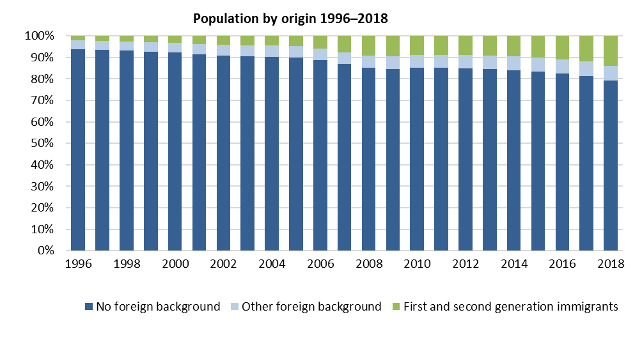
Before jumping into more facts, I think it is helpful to quickly go over some important definitions on the Statice.is website. I think this is useful for later on when I share more data.
As we are all aware, an immigrant is a person born abroad whose parents are foreign born. In addition, the grandparents of an immigrant are also foreign born. The data on Statice.is separates the count of first and second generation born people living in Iceland. First generation immigrants are people who were born abroad and moved to Iceland. While second generation immigrants are those who were born in Iceland but have parents of foreign origin. A person in Iceland with one parent of foreign origin is considered to have a foreign background.
It was also announced that the number of second generation immigrants in Iceland increased from 4,861 in 2018 to 5,263 in 2019.
Like me, you might be wondering where these people are coming from, why they are moving to Iceland and what impact this is having on the country.
What Countries Do Immigrants in Iceland Come From?
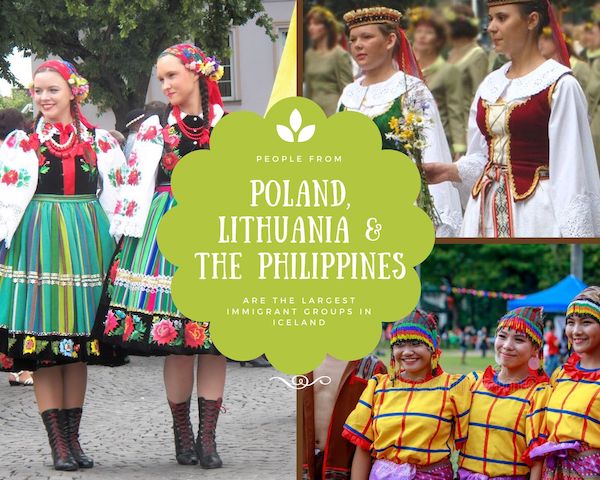
As in recent years, Polish people have made up the majority of immigrants to Iceland. In 2019, there were 19,172 Polish people living in Iceland. That is 38.1% of the immigration population. Following them are Lithuanians (2,884). The third largest immigrant group are people from the Philippines (1,968).
Why Do People Move to Iceland?
People move to Iceland for many reasons. If you listened to episode 34 of this podcast, you will know that I moved to Iceland because I fell in love with an Icelander. While love is a reason that some move here, many of the immigrants from Poland, Lithuania and the Philippines come for work and to have a higher standard of living. It certainly helps that wages are higher here than in their countries. Plus, there are many opportunities to study and have careers in this country.
Where Do Most Immigrants Live in Iceland?
Regarding where people of foreign origin live in Iceland, it is no surprise that the majority of them reside in the capital area. 63.6% of first and second generation immigrants live there. As a whole, more than 60% of the country’s population lives in the capital area, so it makes sense that immigrants end up living there as well.
What Impact is a Growing Population of Immigrants Having on Iceland?
Because immigration has only started to grow rapidly in the last 8 years, there isn’t a lot of information on how this growth is affecting Icelandic society. What I am aware of is that Icelanders are afraid that their language will die out if immigrants don’t learn Icelandic. To be fair, the use of English among teenagers is also a big concern. However, that is another story for another day.

One challenge that immigrants here face is that it takes a lot of time and effort to learn Icelandic. If you are working full-time and trying to learn the language, you can quickly become overwhelmed. Another challenge is that English is widely spoken. The immigrants that speak English in Iceland end up relying on that to communicate. Plus, most Icelanders like to practice their English, so it becomes a vicious cycle.
Learning Icelandic Can Be Challenging
However, there are many immigrants that have learned the language. There are also some that have lived here for decades and can hardly speak it. A study was published in 2017 in the Nordic Journal of Migration Research about immigrants learning Icelandic. It is titled “Immigrant Experiences of Learning Icelandic and Connecting with the Speaking Community”. The study was written by Unnur Dís Skaptadóttir and Pamela Innes. It sheds some light on the obstacles that immigrants in Iceland face when learning the language. I recommend checking it out via the link in the show notes.
What I love about Icelanders is that many of them are very open to multiculturalism. Iceland has been isolated for centuries, yet the many people here feel diversity can have a positive effect on their society. Personally, I am seeing Icelandic traditions living alongside newly introduced traditions from other countries.
It is funny to me that Icelanders have been adopting traditions from the United States. Halloween and Thanksgiving are becoming more popular here. I believe that mainstream media and that the U.S. is kind of idolized here are the contributing factors as to why traditions from there are becoming more popular in Iceland.
8. Iceland on the Grey List
Number 8 shocked me when I first got wind of it. In October of 2019, Iceland was added to the Financial Action Task Force’s (FATF) Grey List. This is due to the fact that the country has not taken sufficient measures to combat money laundering and the financing of acts of terrorism. In 2018, the FATF gave recommendations to Iceland but the country failed to comply with all of them. In a follow up report, the FATF urged the Icelandic government to address all of the recommendations but they were a bit slow to act.
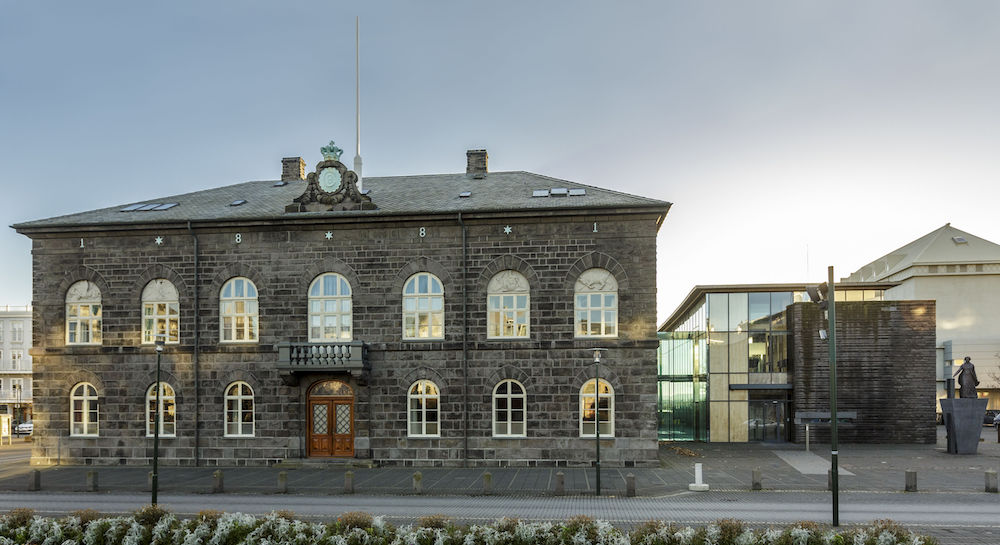
I have to point out that Parliament did enact two laws after getting the recommendations. The first states that organizations whose purpose is to distribute funds in the public’s interest and that operate across borders must be registered with the Directorate of Internal Revenue. The second bill allows for the government to sell assets that have been frozen or confiscated during a criminal investigation. Of course, conditions apply in that case.
Being grey listed sucks because it puts a stain on the country’s reputation, However, no one is sure if it will have a huge impact regarding business. It could make it more difficult for Icelandic companies to do business abroad but we just have to wait and see. As a resident of the country, it concerns me that the Icelandic parliament has allowed for this to happen. It also makes me wonder just how often these crimes are happening.
7. Icelandic National Police Commissioner Scandal
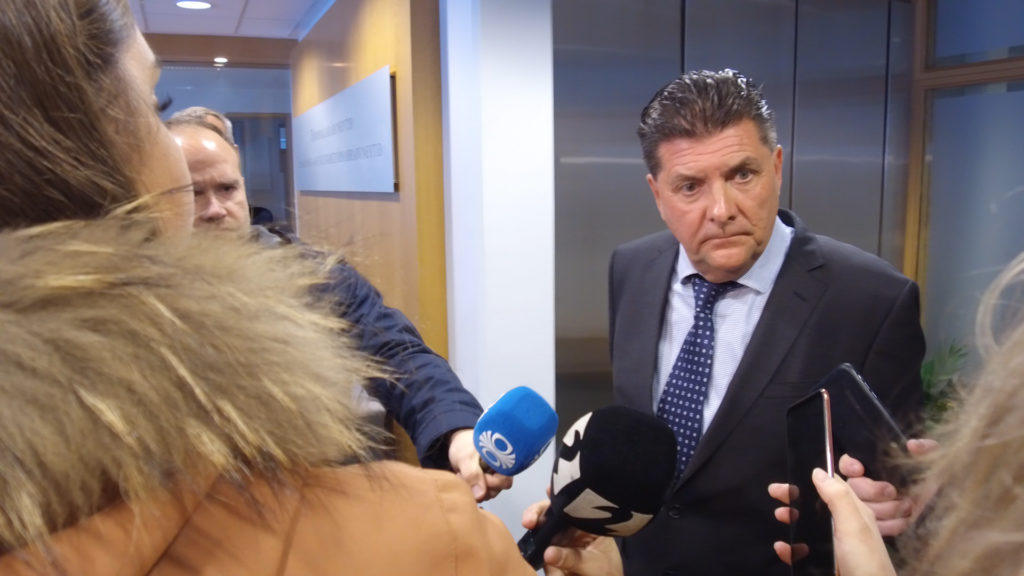
The drama in number seven feels like something out of a soap opera. The Icelandic National Police Commissioner, Haraldur Johannessen, found himself in hot water with regional police commissioners after making some comments regarding corruption. According to Iceland Review, Haraldur said that he is being
“…strategically run out of office by intentional mistruths and slander about his person. He alluded to corruption within the police force and that his stance had made him some enemies before, stating that if he would lose his position, he’d go into more detail on power struggles behind the scenes.”
Haraldur Johannesen
This statement resulted in eight out of the nine regional police commissioners voting no confidence in Haraldur. They called for him to be removed from office.
A History of Controversy
For the last five years, the relationship between the regional police officers and Haraldur have been rocky. It doesn’t help that communication has been poor and that it has been said that Haraldur leads by fear. In addition to the no confidence vote by the regional police commissioners, a vote of no confidence was also declared by the National Police Federation.
Stundin, an Icelandic newspaper, published an article during the summer of 2019 about Haraldur. It listed some of his actions and internal disputes during his tenure as the national police commissioner, a position he has held since 1998. Allegedly, he mismanaged finances, bullied people in the organization, and after the financial collapse in 2008, he damaged the investigations of the National Commissioner’s Economic Crime Department.
Not surprisingly, Haraldur refused to step down when the story broke in September. While the votes of no confidence are an important step in potentially removing Haraldur from office, the final decision had to be made by the Minister of Justice Áslaug Arna Sigurbjörnsdóttir.
Haraldur’s Controversial Resignation hits Iceland News Headlines
In December it was reported that Haraldur Johannessen would resign but this was also controversial. In exchange for leaving office, he will stay on the payroll for all of 2020 and 2021. Each month he will receive a salary of 1,750,000 ISK ($14,249). During that time he will advise the Minister of Justice on the changes to the organization. In 2022, he will take a paid leave of absence for three months. This cushy resignation was described as a “reward” for Haraldur’s many years of service as the National Police Commissioner. This caused outrage among many, including the chairman of Iceland’s biggest labor union, VR.
Personally, I find this to be ridiculous. Historically, people in power get a decent amount of perks, usually monetarily, when they are forced to resign. I find it annoying that Iceland reminds me of the U.S. in this way.
6. Hatari Showing the Palestinian Flag at the Eurovision Contest in Israel
Number six is another controversial Iceland news story, but in a much different way than what you just heard. If any of you watched Eurovision in 2019, then you are fully aware of Hatari, the band that represented Iceland in the singing contest last May. Hatari translates to Haters. This band has caused quite a stir in Iceland before ever making international headlines for what they did at Eurovision in Israel. The Rekjavík Grapevine has an awesome article titled “Six Times Icelandic Eurovision Stars Hatari Trolled the World”. I highly recommend reading it just to get a better idea about their antics.

The Independent describes Hatari as “…a hyper self-aware, super satirical and pointedly political BDSM trio.” Quite a combination for a band in a song contest that actively discourages blatant political messages. Also, I was very surprised that a BDSM dressed group with a song called “Hatrið Mun Sigra (Hate will prevail)” made it to the finals. This is a satirical, anti-capitalist group and their song is meant to bring attention to the fact that hate will indeed prevail if we people don’t unify. On top of the messaging, the song is quite good. I have included the music video in the show notes. It has English subtitles.
Icelanders Knew Hatari Would do Something
Icelanders expected that Hatari would do something controversial at the event and they were right. During the announcement of votes, three members of the group held up the Palestinian flag when the camera showed them in the green room. Israelis were very upset about this and it was considered a political statement by the Eurovision board. Some people in the crowd booed when they saw the flag. While some Icelanders were proud that Hatari did this, others felt that they could have done more.
To give you some background, Iceland was the first western European nation to officially recognize Palestine as an independent state in 2011. Also, some Icelanders boycotted watching Eurovision in 2019 because it was being held in Israel. It is important to understand that Icelandic people do not hate Israelis. Rather, they are very upset about the treatment of Palestinians by the Israeli government.
Consequences for Hatari’s Actions in Israel
Some feared that Hatari’s action would get Iceland banned from the Eurovision contest. In the end, two interesting things happened. The first is that the European Broadcasting Union issued a fine to RÚV, the national public service broadcasting organization in Iceland. The fine was for 5000 euros. While RÚV complained that they were unhappy with the fine, they also said they were proud of Iceland’s contribution to the competition. RÚV also decided that they will participate in the contest again in 2020.
The second thing that happened is that the three members of Hatari that flew the Palestinian flag were deliberately given the worst seats on their El Al flight, which is an Israeli airline. This flight was the first leg of their journey home and they were given middle seats. According to a tweet by Daher Dahli, the ground crew of EL AL bragged about giving them terrible seat assignments, saying “This is what they get.”
5. 10 Years Since the Pots and Pans Revolution
The fifth Iceland news story on this list is that 2019 marks ten years since the Pots and Pans Revolution in Iceland. The name is a translation of the Iceland word – búsahaldabyltingin. This revolution happened after the economic meltdown in the country in 2008. During that year, people were protesting and holding rallies outside of parliament because the elected officials had failed to adequately respond to the country’s financial system collapsing.
The combination of an irresponsible government, physical altercations with the police, arrests, and a growing number of protesters resulted in this revolution. Left and right ministers resigned or stated they would not run for office again. By late January of 2009, the government resigned and an emergency coalition had to be formed. It is widely reported that Iceland locked up all of the bankers responsible, created a new constitution and implemented it. The truth is that some bankers were jailed and a new constitution was written but it has never been used. It has been collecting dust in a drawer for the past decade.
The other unfortunate part is the same political parties that led the country down the path to collapse – the Independence Party and the Progressive Party, were back in power in 2013. To add insult to injury, there has been talk recently about privatization of the banks again, which is a huge contributing factor for the financial collapse of 2008. Hopefully, Icelanders don’t allow for this foolishness to happen again.
4. Funeral for Ok Glacier
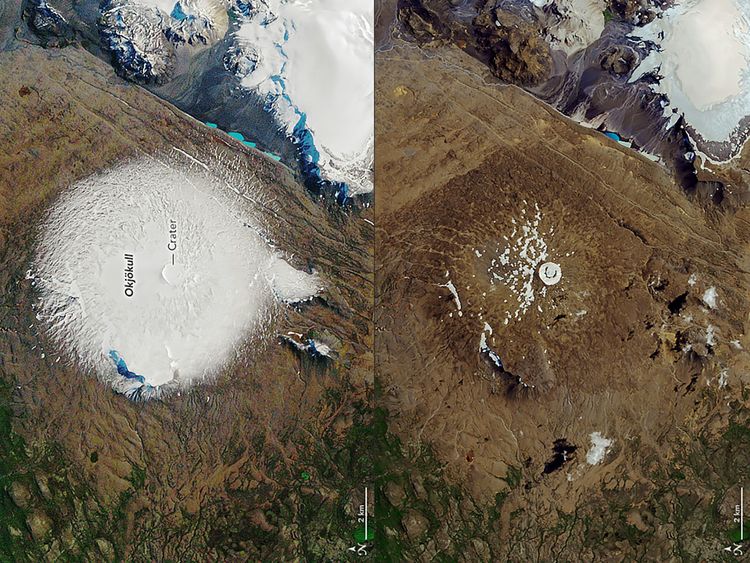
Number four attracted a lot of international coverage because it shows just how much of an impact the climate crisis is having on Iceland. During the summer, a funeral was held for Okjökull glacier. It’s the first glacier killed by climate change. Because it has lost its glacier status, it is now just referred to as Ok. The ceremony was attended by Iceland’s Prime Minister Katrín Jakobsdóttir, Mary Robinson, the former United Nations High Commissioner for Human Rights, Andri Snær Magnason, an Icelandic author that I’ve had the pleasure of interviewing, and many others.
A Memorial Plaque for a Glacier
Andri Snær wrote this message on a memorial plaque that now sits on OK,
“Ok is the first Icelandic glacier to lose its status as a glacier. In the next 200 years all our glaciers are expected to follow the same path.This monument is to acknowledge that we know what is happening and what needs to be done. Only you know if we did it.”
Andri Snær Magnason
According to Science Alert “Along with this passage, the memorial also includes the number 415ppm (parts per million) CO2: the record level of carbon dioxide in our atmosphere reached in May this year, the first time this has happened in human history.”
This funeral was covered in many publications, such as The Guardian, NY Times, BBC, The New Yorker and more.
I have personally witnessed the rapid receding of glaciers in Iceland and it is troubling. If you go on a glacier walk with a guide company in Iceland, you will undoubtedly hear about how fast the glacier is melting.
Andri’s New Book About The Climate Crisis
As mentioned in my interview with Andri, he is an environmental advocate who has been fighting on the front lines to protect Icelandic natural resources from money hungry politicians and overseas investors. In the later part of 2019, his new book “On Time & Water” was released in Iceland. The intention of the book is to “ make you understand what our future holds for all of us if we don’t act immediately.”
Like the funeral, his book has received a lot of international attention and will soon be available in 14 languages.
3. Iceland’s Amazing & Awful Weather in 2019
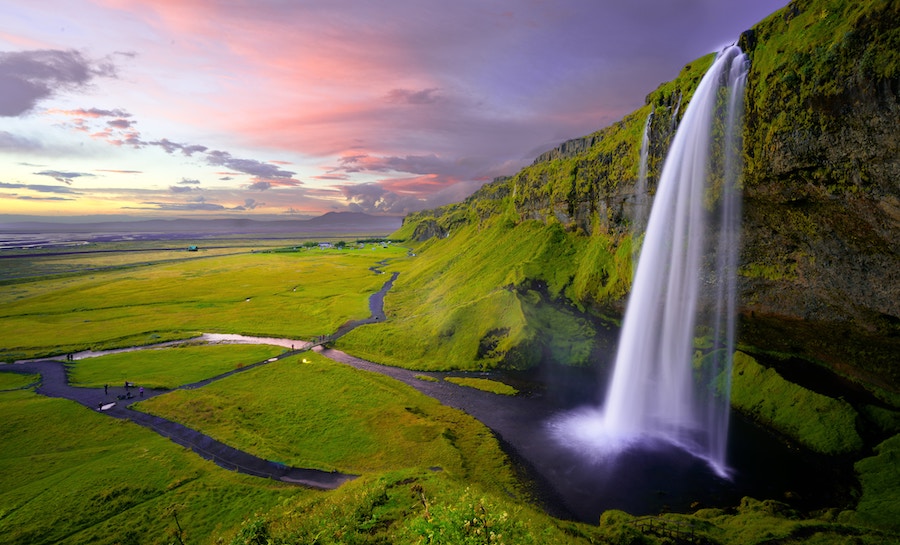
Icelandic weather is notorious for being unpredictable, but 2019 brought about some surprising conditions for Icelanders and foreigners. The spring, specifically April and May, saw temperatures that were above average. In July, there was a heatwave, which I have to laugh at because the temperatures hit 25.9°C (78.6°F) recorded in North Iceland and 26.9°C (80.4°F) in South Iceland. As a native New Yorker, those temperatures are nowhere near what I experienced when a heatwave was announced in the City. However, I have to admit that I have started to acclimate to Icelandic weather, so it felt quite warm to me. I was pleasantly surprised by the amount of sunny days in Reykjavík during the summer. 2019 ended up being the third sunniest year in the city’s history.
2018 Summer in Iceland Was One of the Worst on Record
For those that aren’t aware, Icelanders needed a good summer last year because 2018 was awful. To give you an idea of just how bad it was, the Icelandic Meteorological Office recorded only 70.6 hours of sunshine in June! When compared to a 10 year average, that is only a third of what happens normally. It was a cold and cloud covered summer. People were miserable. Everyone was hoping that 2019 would be better, and thankfully it was in the summer, fall and part of December.
Unfortunately, Iceland experienced its worst storm in about 25 years in December. The blizzard, wind and ice conditions were so dangerous that people were urged to stay off the roads. It is normal for Iceland to have storms but this one caused a lot more damage than anticipated. Around 20,000 people lost power, the wind topped 100 mph in some places, a teenager and about one hundred horses died because of the storm.

The government was criticized by locals after the power outages because these areas need updated infrastructure to ensure that the power stays on.
Casualties of the 2019 Winter Storm
The teenager, Leifur Magnús Grétarsson Thislan, was helping to clear ice from a generator when he fell into an icy river and was swept away. While Iceland does have hot springs that can be used for geothermal energy in different parts of the country, many people don’t live near a hot spring so they use hydro powered generators for electricity. Over 40 volunteers searched for the Leifur. Unfortunately, the conditions of the storm made it difficult to find him quickly. When he was found, he was already dead.
Regarding the horses, it is important to know that Icelandic horses normally stay outside during the winter. Some farmers have shelters set up for horses, if they need additional protection. While the horses are a very sturdy breed, they were no match for this storm. About one hundred horses were buried under two meters (about 6.5 feet) of snow. There is a photo of a farmer that was able to dig out his horses and save them. Unfortunately, not every farmer was so lucky. The horse deaths equate to less than 1% of the horse hit by the storm.
2. WOW Airline Collapsed
The collapse of WOW Airlines claimed the number two spot on the 2019 Iceland news list. This story flooded the Iceland news headlines, and caused widespread fear about the stability of the economy. I am dedicating a full episode to the rise and fall of the airline on the one year anniversary date that it went under. Keep a lookout for that in March.

In 2011, the airline launched and quickly rose to become one of the go to airlines for people traveling to different destinations in the world. It’s incredible that in just six years of operation, it had grown so quickly. The airline had transported millions of people, had a fleet of 20 planes, employed over a thousand people, and flew to thirty-five international cities.
The Fall of WOW Air
Between 2017 and 2018, the financial troubles started to rise to the surface. The airline announced a loss of ISK 4.8 billion ($39.3m). A combination of growing too fast and a bad deal with fuel prices caught up with the founder of WOW. At one point Icelandair considered buying the airline, but that fell through. Keep in mind that Icelandair is Iceland’s national airline and is essentially too big to fail. It was also WOW Air’s direct competitor. That must have made it hard for Skúli to humble himself and ask them for financial support. Indigo Partners, owners of Wizz Air, also considered buying the airline but that fell through too.
Lack of funds meant drastic measures had to be taken. Mass layoffs followed and people in tourism tried to prepare for the worst. Overall, the economy has been fine and the tourism industry has been stable.
However, the story isn’t over yet. A few groups of people have come forward, including Skúli, with announcements of new airlines to replace WOW Air. This pops up in Iceland news headlines everyone couple of months. As of right now (early January 2020), none of them are in operation. I look forward to sharing more about this story in a couple of months.
1. Samherji Scandal Tops the Iceland News Stories for 2019
The top spot on this list goes to the Samherji scandal (aka Fishrot Files) because it has rocked the nation. In fact, investigations are still going on. Samherji is a fishing and fish processing company in Iceland.
According to Stundinn, it is the largest fishing company in Iceland and one of the largest in Europe. Kveikur, an investigative news program on RÚV national public broadcasting network, broke the story.
On their website, it says that,
“For the past decade Samherji has paid hundreds of millions of Icelandic krona to high ranking politicians and officials in Namibia with the objective of acquiring the country’s coveted fishing quotas.”
Kveikur
All of this came to light after whistleblower, Jóhannes Stefánsson revealed the corruption. From 2012 to 2016, Jóhannes was the Managing Director of Operations for Samherji in Namibia. He collected documents on his computer to prove that the company was paying bribes for the quotas and profiting from Namibia’s natural resources. The documents were shared with Wikileaks, who has published 30,000 of them on their site. Of course, this made Iceland news and international headlines.
It was revealed that Samherji had established an offshore shell company in the Marshall Islands to funnel money it made from the fishing quotas in Namibia. Naturally, the tax authorities in Iceland have opened up an investigation.
Consequences of the Scandal
As a result of this scandal being revealed, the CEO of Samherji Þorsteinn Már Baldvinsson has stepped aside indefinitely. Bernhardt Esau, the Namibian Minister of FIsheries and Sacky Shangala, the Minister of Justice in Namibia resigned. Six people were arrested in Namibia while none have been arrested in Iceland.
This scandal certainly isn’t helping to combat Iceland’s money laundering issue that I spoke about in number 8 on this list. I recommend checking out the hour long video that Kveikur put together about this scandal. Link in the show notes.
Share Your Thoughts About These Iceland New Stories
I hit on a lot of stories in this episode and I would love to hear your thoughts about them. To share, you can write in the comment section below.
Random fact of the episode
There was one popular Iceland news story that I did not include on the top ten list. It did go viral but for all the wrong reasons. Two Icelandic seamen committed the cruel act of cutting off the tail of a living young shark. After mutilating it, they threw it back in the water. In the video footage , one of the men is heard saying “Good luck trying to swim, you bastard!”
There is laughing heard in the background as the shark is bleeding profusely as it tries to swim away. Christel Ýr Johansen got hold of the video and shared it on their Facebook account to bring light to what these men did. The seamen were fired for this cruel act. It was reported on RÚV that the men broke several laws. They may face up to a one million krona fine from animal cruelty charges.
Icelandic word of the episode
Newspaper article – blaðagrein
Blað – paper
Grein – article
I hope you enjoyed listening to this episode of the All Things Iceland podcast. For your convenience and listening pleasure, this podcast is available on many platforms. You can listen on Spotify, Apple Podcasts, Google Podcasts, Stitcher, and pretty much any platform that plays podcasts. If you think someone else will find this episode interesting and/useful please share it.
